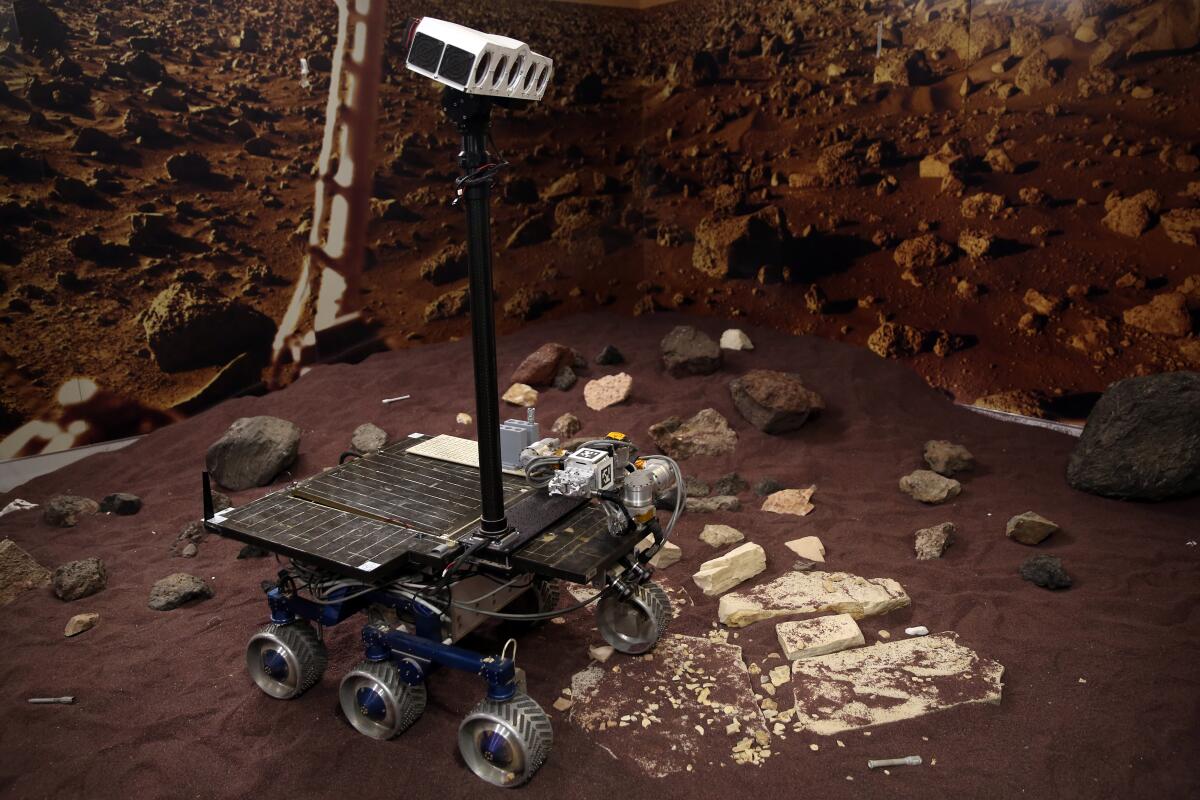Questions about NASA’s Mars Sample Return mission put JPL jobs in jeopardy

- Share via
The Jet Propulsion Laboratory laid off 100 contractors last week and will scale back part of the first-ever effort to bring pieces of Mars to Earth, after a cost-cutting order from NASA that lawmakers called “short-sighted and misguided.”
In an email to staff on Thursday, JPL director Laurie Leshin said that NASA is bracing for a federal budget that could cap spending on the Mars Sample Return mission at $300 million this fiscal year — just 36% of the previous year’s $822-million budget and less than one-third of the $949 million the Biden administration requested for the program.
“Adjusting to such a large budget cut in one year will be painful,” Leshin wrote to employees at the federally funded La Cañada Flintridge research institution. “It is also becoming more likely that there will be JPL workforce impacts in the form of layoffs, and the way such JPL workforce actions are implemented means that the impact would not be limited to MSR.”
Last week’s layoffs of contract employees along with a hiring freeze are part of a lab-wide effort to reduce spending, Leshin wrote. In addition, NASA has ordered JPL to cease operations at the end of this month on a key project within the mission to bring a piece of Mars back to Earth, a joint project with the European Space Agency and one of the biggest and most complex missions undertaken at the lab.
Work on Mars Sample Return’s Capture, Containment and Return System will be paused while an independent review team analyzes the overall design of the much-anticipated mission to collect dust and rocks from Mars and bring them to Earth for study, Leshin wrote.
“These are painful but necessary adjustments as we work through the current budget environment while striving to maintain our unique skills and world-class workforce for NASA and our nation,” JPL said in a statement.
After years of planning, NASA and the Jet Propulsion Laboratory will go ahead with a mission to visit Mars and bring a sample of Mars back to Earth.
The cuts come while Congress is still debating how it’s going to parcel out the 2024 fiscal year budget.
Lawmakers have criticized the agency’s decision to scale back on staff and science on the Mars effort before final numbers are in.
“NASA’s unilateral and unprecedented decision to cut funding for the Mars Sample Return mission, before Congress has finished its appropriations process, is having devastating real world consequences,” Rep. Adam Schiff said on Friday. “This critical mission was identified as NASA’s highest scientific priority by the decadal survey, and to back away now will relinquish important American leadership in space science.”
The sample retrieval lander was originally scheduled to take off in 2028, with a planned return to Earth in 2033 after the first-ever rocket launch from another planet.

An independent review of the project that NASA commissioned last year found that the mission was “not arranged to be led effectively,” and that there was a “near zero probability” that it would make its 2028 launch date. Even meeting a postponed launch date of 2030 would require more than $1 billion a year for at least three years starting in 2025.
The mission’s final price tag could be nearly $10 billion, the review concluded — more than double the $4.4 billion estimated in 2020.
California lawmakers have lobbied to preserve JPL’s funding, citing the need to protect jobs and keep the U.S. space program competitive. China has announced a sample return mission of its own to launch in 2028 or 2030 — a prospect, the review stated, that would “challenge the USA’s technical, engineering, and scientific leadership in Mars exploration.”
In a November letter to NASA Administrator Bill Nelson, a bipartisan group of six California lawmakers in the U.S. House and Senate said they were “mystified” by NASA’s preemptive belt-tightening before a final budget was announced.
Implementing the cuts ordered by NASA means JPL “will not be able to meet the 2030 launch window, billions of dollars in contracts supporting American businesses will be subject to cancellation, and hundreds of highly skilled jobs in California will be lost,” they wrote. “If this uniquely talented workforce is lost to the private sector, it will be near impossible to reassemble.”
Engineer Loay Elbasyouni was integral to NASA’s 2020 mission to Mars, 293 million miles away. Now, with his parents trapped in Gaza, the 20-mile distance that marks the difference between war and refuge seems more remote.
In the most recent planetary science decadal survey, a report prepared for NASA every 10 years by the National Academy of Sciences, Engineering, and Medicine, planetary scientists named the Mars Sample Return mission as the “highest scientific priority of NASA’s robotic exploration efforts this decade” and argued that the program should be completed “as soon as is practicably possible with no increase or decrease in its current scope.”
But the authors cautioned that the ambitious mission shouldn’t come at the cost of other planetary science.
“Mars Sample Return is of fundamental strategic importance to NASA, U.S. leadership in planetary science, and international cooperation and should be completed as rapidly as possible,” the report stated. “However, its cost should not be allowed to undermine the long-term programmatic balance of the planetary portfolio.”








